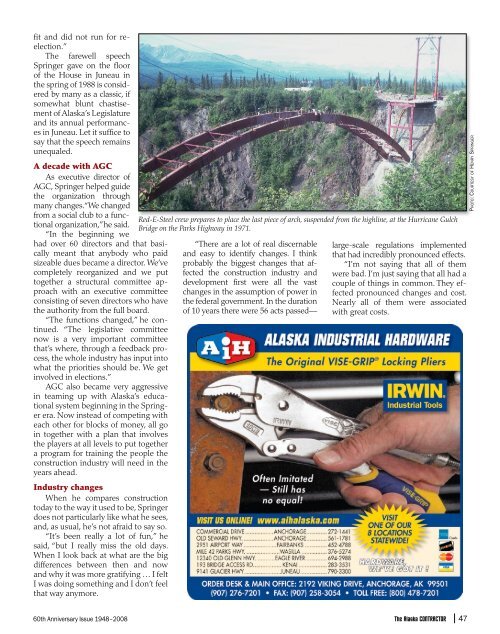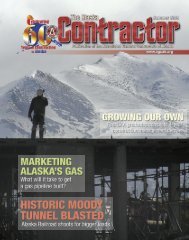The Alaska Contractor: Special 60th Anniversary Issue
The Alaska Contractor: Special 60th Anniversary Issue
The Alaska Contractor: Special 60th Anniversary Issue
You also want an ePaper? Increase the reach of your titles
YUMPU automatically turns print PDFs into web optimized ePapers that Google loves.
fi t and did not run for reelection.”<br />
<strong>The</strong> farewell speech<br />
Springer gave on the fl oor<br />
of the House in Juneau in<br />
the spring of 1988 is considered<br />
by many as a classic, if<br />
somewhat blunt chastisement<br />
of <strong>Alaska</strong>’s Legislature<br />
and its annual performances<br />
in Juneau. Let it suffi ce to<br />
say that the speech remains<br />
unequaled.<br />
A decade with AGC<br />
As executive director of<br />
AGC, Springer helped guide<br />
the organization through<br />
many changes. “We changed<br />
from a social club to a functional<br />
organization,” he said.<br />
“In the beginning we<br />
had over 60 directors and that basically<br />
meant that anybody who paid<br />
sizeable dues became a director. We’ve<br />
completely reorganized and we put<br />
together a structural committee approach<br />
with an executive committee<br />
consisting of seven directors who have<br />
the authority from the full board.<br />
“<strong>The</strong> functions changed,” he continued.<br />
“<strong>The</strong> legislative committee<br />
now is a very important committee<br />
that’s where, through a feedback process,<br />
the whole industry has input into<br />
what the priorities should be. We get<br />
involved in elections.”<br />
AGC also became very aggressive<br />
in teaming up with <strong>Alaska</strong>’s educational<br />
system beginning in the Springer<br />
era. Now instead of competing with<br />
each other for blocks of money, all go<br />
in together with a plan that involves<br />
the players at all levels to put together<br />
a program for training the people the<br />
construction industry will need in the<br />
years ahead.<br />
Industry changes<br />
When he compares construction<br />
today to the way it used to be, Springer<br />
does not particularly like what he sees,<br />
and, as usual, he’s not afraid to say so.<br />
“It’s been really a lot of fun,” he<br />
said, “but I really miss the old days.<br />
When I look back at what are the big<br />
differences between then and now<br />
and why it was more gratifying … I felt<br />
I was doing something and I don’t feel<br />
that way anymore.<br />
Red-E-Steel crew prepares to place the last piece of arch, suspended from the highline, at the Hurricane Gulch<br />
Bridge on the Parks Highway in 1971.<br />
“<strong>The</strong>re are a lot of real discernable<br />
and easy to identify changes. I think<br />
probably the biggest changes that affected<br />
the construction industry and<br />
development fi rst were all the vast<br />
changes in the assumption of power in<br />
the federal government. In the duration<br />
of 10 years there were 56 acts passed—<br />
large-scale regulations implemented<br />
that had incredibly pronounced effects.<br />
“I’m not saying that all of them<br />
were bad. I’m just saying that all had a<br />
couple of things in common. <strong>The</strong>y effected<br />
pronounced changes and cost.<br />
Nearly all of them were associated<br />
with great costs.<br />
<strong>60th</strong> <strong>Anniversary</strong> <strong>Issue</strong> 1948–2008 <strong>The</strong> <strong>Alaska</strong> conTrAcTor 47<br />
PH O TO: CO U R T E SY O F HE N RY SP R I N G E R

















